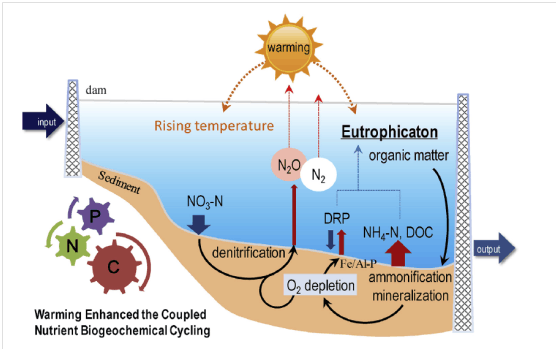作 者:Zhou, XP;Chen, NW; Yan, ZH; Duan, SW影响因子:4.295
刊物名称:ENVIRONMENTAL POLLUTION
出版年份:2016
卷:219 页码:490-500
Increases in water temperature, as a result of climate change, may influence biogeochemical cycles, sediment-water fluxes and consequently environmental sustainability. Effects of rising temperature on dynamics of nitrate, nitrite, ammonium, dissolved inorganic nitrogen (DIN), dissolved reactive phosphorus (DRP), dissolved organic carbon (DOC) and gaseous nitrogen (N2and N2O) were examined in a subtropical river (the Jiulong River, southeast China) by microcosm experiments. Slurry sediments and overlying water were collected from three continuous cascade reservoirs, and laboratory incubations were performed at four temperature gradients (5 °C, 15 °C, 25 °C and 35 °C). Results indicated: (1) warming considerably increased sediment ammonium, DIN and DOC fluxes to overlying water; (2) warming increased retention of nitrate, and to a lesser extent, nitrite, corresponding to increases in N2and N2O emission; (3) DRP was retained but released from Fe/Al-P enriched sediments at high temperature (35 °C) due to enhanced coupled transformation of carbon and nitrogen with oxygen deficiency. Using relationships between sediment fluxes and temperature, a projected 2.3°C-warming in future would increase ammonium flux from sediment by 7.0%-16.8%, while increasing nitrate flux into sediment by 8.9%-28.6%. Moreover, substrates (e.g., grain size, carbon availability) influenced nutrient delivery and cycling across cascade reservoirs. This study highlights that warming would increase bioreactive nutrient (i.e., ammonium and phosphate) mobilization with limited gaseous N removal from sediments, consequently deteriorating water quality and increasing eutrophication with future climate change.

Fig. 7.Conceptual diagram of warming potential on coupled biogeochemical processes andfluxes of major bioreactive elements (N, P and C) from sediments across cascade reservoirs.

